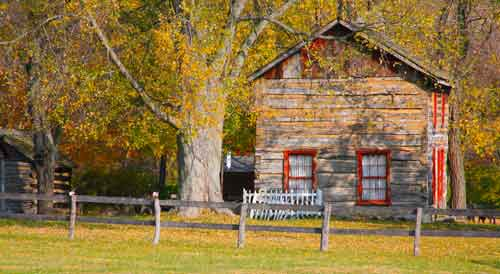February 16, 1850 – A meeting is held to build a turnpike from Wilmington to Waynesville. Road is finished in 1852, with seven miles planed over low area. Blue laws frown on Sunday commercial travel. West of town, on a Sunday morning, a young horseman meets a deacon. "Are you on an errand to visit the sick?" asks deacon. "My mother is lying dead," answers rider solemnly. Deacon waves horseman through toll gate, at which moment horseman shouts, "She has been lying dead for ten years!"
The low areas which would be planked were most likely in the Caesar Creek area which is now Caesar Creek State Park.

On the Touring Ohio Magazine Website is this picture of a former Toll House, now located in Pioneer Village at the Park. The description reads as follows:
Unlike today, early roads were usually developed and maintained by private citizens. To help pay for these endeavors, tolls were collected at various points along the road at toll houses. The toll house not only collected the tolls, but they also provided food and drink, plus they sometimes provided lodging for travelers. This toll house was located along the Waynesville-Wilmington Pike at the Massie-Wayne [Warren County] Township line. Later it was moved across Route 73 where it became a farm granary around 1900.
Even Prior to 1850 there is a state road from Wilmington to Waynesville, however, as The History of Warren County by Josiah Morrow (1882) states that Warren County received $1000 from the state for roads in 1820 and $50 was allotted to the road from Wilmington to Waynesville. The biggest chunk, $145, went to the road from Cincinnati to Chillicothe by John Hopkins's tavern on the east side of the Little Miami. Col. John Hopkins, born November 5, 1786 moved to Warren County in 1804 and served in the War of 1812.
Most of the following information is from The Townships History section of the Wilmington and Clinton County's Bicentennial 1810-2010 Wilmington and Clinton County's Bicentennial 1810-2010 web page and from Pioneer Migration Routes through Ohio website.
Adams Township (Currently I-71, SR3-3C Hwy, SR380). The Wilmington-Lebanon Road was built in 1812 as a toll road. George Road was first named the Bull Skin Trace as early as 1687. This Native American Trail connected the Bull Skin Trace which ran partly along Caesar Creek, at Clarksville with the Kanawha Trace (SR73).
Bull Skin Trace is now a hiking trail in the Caesar Creek State Park. Also known as the Bullskin Road, this was the first State Road in Ohio, receiving official recognition of the state in 1807 as the Xenia State Road, traveling from the British Fort Detroit to Bullskin Landing above Cincinnati in Clermont County on the Ohio River.
The Kanawha Trace is named for the river in WV and this website shows an early 1800s mile by mile progress a settler could follow from North Carolina to Richmond Indiana, passing through Leesburg and Highland, then to Wilmington via Morgantown, a village in Green Township where College Township Road crossed Simon Kenton Trace -- south of Snow Hill. Morgantown, settled in 1816 was abandoned in 1829 due to a cholera epidemic.
In the 1930s there was a Civilian Conservation Camp on Clarksville Rd as part of the WPA program.
Marion Township (Blanchester) in SW Clinton County had the Tar Pike, connecting Kansas/Pansy with Midland. Other information about the history/transportation modes of Marion Township according to the Clinton County Bicentennial History website includes the 1860 location of the village of Kansas where Tar Pike mets SR730. It had a grist mill and general store. After building the post office, the name was changed to Pansy.
SR123 was a Native American Trail used by the Adena people 5000 years ago and connected various mounds.
In 1905 Marion Township was the only location in the county with an Interurban Traction Railroad* which went from Blanchester to Cincinnati and was built by Barney Kroger (1860-1938), who opened his first grocery, the Great Western Tea Co. in 1883. He renamed the company Kroger Grocery and Baking in 1902 and opened 5500 stores by the end of the 1920s.
*GHU had a Traction RR almost in her front yard as a teenager. See September 2, 1910 Grandma Takes Traction blog post for more information.
No comments:
Post a Comment